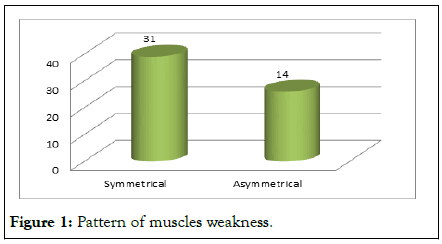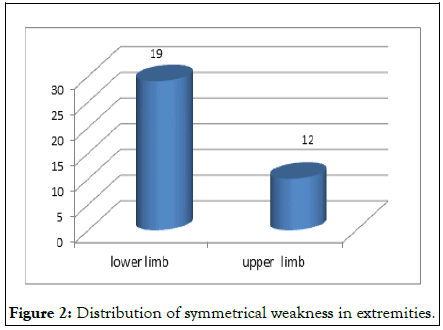Anatomy & Physiology: Current Research
Open Access
ISSN: 2161-0940
ISSN: 2161-0940
Research Article - (2023)Volume 13, Issue 2
Muscular weakness is one of the most common neurologic presentations in patients with Guillain-Barre Syndrome (GBS).
Objectives: The purpose of this study was to determine the muscles weakness distribution in the limbs in patients with Guillain-Barre syndrome.
Methods: This study was a descriptive cross-sectional study conducted in faculty of medicine, Gadarif university to determine the muscle weakness in extremities in patients with Guillain-Barre Syndrome in Gadarif, eastern Sudan. The data was collected from Gadarif pediatrics teaching hospital in Eastern Sudan during the period from January 2017 to December 2022.
Results: Forty-five (45) patients with diagnosed Guillain-Barre Syndrome were collected in the study period. There were 26 (57.8%) males and 19 (42.2%) females with a male to female ratio 1.4: 1. The mean age was 7.22 years ± 3.7 years (the age’s ≤ 15 years). 31 (68.8%) patients had symmetrical weakness in upper and lower limbs, of them, 19 (61.3%) patients had symmetrical lower limb weakness. Asymmetrical right lower and upper limb weakness was 4/6 and 5/8 respectively.
Conclusion: Symmetrical weakness was most prominent; in lower extremity weakness was most common proximally, while the distal weakness in UL was common in patients with Guillain-Barre syndrome.
Children; Muscle extremities weakness; Guillain-Barre syndrome; Limb weakness; Tissues
Skeletal muscle is one of the most dynamic tissues of the human body; it comprises approximately 40% of total body weight and contains 50%-75% of all body proteins. Skeletal muscles are composed primarily of contractile tissue [1]. Skeletal muscle is a highly organized tissue containing several bundles of muscle fiber (myofibers). Myofiber represents a muscle cell, its basic cellular unit called the sarcomere. Sarcomeres represent an elegant piece of molecular machinery; it is composed of two main alternating sets of protein filaments: Thin filaments (α-actin) and thick filaments (myosin). Sarcomeres responsible for generating contraction, force, and movement [2]. Skeletal muscle fibers are innervated by motor neurons whose cell bodies are located in the ventral horn of the spinal cord. Nerves are in touch with muscles by motor end plates which convey a stimulus to contract. Skeletal muscle is named for its location is attached to bones by tendons, muscles of the limbs, neck and trunk; lower limb muscle strength is lesser in women compared with men [3].
Loss of skeletal muscle will have negative effect on multiple physiological parameters, such as exercise, respiration, thermoregulation, and metabolic homeostasis [4]. Paralysis or weakness is the loss of voluntary muscle function in one or more parts of the body as a result of damage to the nervous system. Guillain-Barre Syndrome (GBS) is a rapid-onset muscle weakness caused by the immune system damaging the peripheral nervous system [5]. GBS considered the most frequent cause of flaccid paralysis in children, and occurs more frequently in males than in females and the incidence increases with age, although all age groups can be affected [6,7]. Patients with GBS typically present with weakness and sensory signs in the legs that progress to the arms and cranial muscles.
It has an incidence of 0.5-1.5 cases per 100,000 individuals in the population aged 0 years-17 years [8]. It is characterized by symmetrical muscles weakness [9,10], ascending muscle weakness usually involving the lower limbs first, deep tendon reflexes are absent in 90% of patients [11] sensory and autonomic dysfunction [12]. Asymmetric cranial nerve palsies have been reported in patients with GBS [13].
GBS can be classified into classic GBS, which causes weakness and hyporeflexia in the four limbs; pharyngocervic-brachial form, in which there is weakness limited to upper, cervical and bulbar regions; paraparetic GBS, when the weakness is restricted to the lower limbs; bifacial paralysis with distal paresthesia [14]. The objective of this study was to determine the muscle weakness in patients with Guillain-Barre syndrome.
This study was a descriptive cross-sectional study conducted in faculty of medicine, Gadarif university to determine the muscle weakness in extremities in patients with Guillain-Barre syndrome in Gadarif, Eastern Sudan. The data was collected from Gadarif pediatrics teaching hospital in Eastern Sudan during the period from January 2017 to December 2022. A total of 45 children aged 1 years-15 years diagnosed with Guillain-Barre syndrome were enrolled. Informed consent was taken from the parents of the patients. The approval of study was taken from the research and ethical committee of the faculty of medicine, university of Gadarif. Children with signs of upper motor neuron lesion were excluded.
Statistical analysis
Data was analyzed using Statistical Package for Social Sciences (SPSS) software version 21.0. P value<0.05 was considered statistically significant.
Forty-five (45) patients with diagnosed Guillain-Barre syndrome were collected in the study period. There were 26 (57.7%) males and 19 (42.2%) females with a male to female ratio 1.4:1. The mean age was 7. 22 years ± 3.7 years (the age’s ≤ 15 years).
31 (68.9%) patients had symmetrical weakness in upper and lower limbs (Figure 1), of them, 19 (61.3%) patients had symmetrical lower limb weakness (Figure 2). There was statistically significant p=0.000.

Figure 1: Pattern of muscles weakness.

Figure 2: Distribution of symmetrical weakness in extremities.
Symmetrical with proximal muscle weakness in the LL was most frequent represent 13/19 (68.4%) while the distal weakness in UL was 8/12 (66.7) (Table 1). Asymmetrical right Lower and upper limb weakness represent 4/6 and 5/8 respectively.
| Weakness | Lower limb N (%) | Upper limb N (%) |
|---|---|---|
| Symmetrical | ||
| Proximal | 13/19 (68.4%) | 4/12 (33.3%) |
| Distal | 6/19 (31.6%) | 8/12 (66.7%) |
| Asymmetrical | ||
| Right | 4/6 (66.7%) | 5/8 (62.5%) |
| Left | 2/6 (33.3%) | 3/8 (37.5%) |
Table 1: Area of weakness.
Muscle weakness or paralysis is the characteristic features of Guillain-Barre syndrome, which can affect the neuromuscular pathway (lower motor neurons, neuromuscular junction, and muscle fibers) at any level. Lower motor neurons are located in the anterior horn of the spinal cord, nerve roots, and peripheral nerves [15,16].
In the present study, more than half of the patients have symmetrical limb weakness (68.9%). While asymmetric weakness represented 31.1%. This finding was in line with previous study. Alzaidi and Nouri [17] reported that symmetrical muscle weakness was the most frequent, present in 96% of patients. Yosha-Orpaz, et al. reported that asymmetric weakness accounted for 23% in children with GBS. Jain, et al. found severe sensorimotor, axonal, and demyelinating peripheral neuropathy of the bilateral upper and lower extremities in acute GBS in addition to that the muscle stretch reflexes were 0. Asymmetric limb weakness in GBS is uncommon and may be confused with other conditions such as stroke [18-20].
In this study symmetrical lower limb greater than upper limb weakness represents 68.4%.
Mustafa, et al. revealed symmetrical upper greater than lower limb weakness, bilateral weakness is the main symptom at GBS, patient present with lower limbs weakness then ascend to the upper extremities.
In this study symmetrical with proximal muscle weakness in the LL was most frequent 13/19 (68.4%) while the distal weakness in UL was 8/12 (66.7). Asymmetrical right Lower and right upper limb weakness represent 4/6 and 5/8 respectively. Alzaidi and Nouri found that the upper extremity weakness was mainly distal in 73% of patients, while lower extremity weakness was mainly proximal in 68% of patients [17].
Symmetrical weakness was most prominent; in lower extremity weakness was most common proximally, while the distal weakness in UL was common in patients with Guillain-Barre syndrome. Therefore, extremities muscle weakness in patients with Guillain-Barre syndrome should be consider it may be helpful in diagnosis and management of the disease in early stages.
The authors declare that, they do not have any conflict of interest regarding this study.
None.
[Crossref] [Google Scholar] [PubMed]
[Crossref] [Google Scholar] [PubMed]
[Crossref] [Google Scholar] [PubMed]
[Crossref] [Google Scholar] [PubMed]
[Crossref] [Google Scholar] [PubMed]
[Crossref] [Google Scholar] [PubMed]
[Crossref] [Google Scholar] [PubMed]
[Crossref] [Google Scholar] [PubMed]
[Crossref] [Google Scholar] [PubMed]
[Crossref] [Google Scholar] [PubMed]
[Crossref] [Google Scholar] [PubMed]
[Crossref] [Google Scholar] [PubMed]
[Crossref] [Google Scholar] [PubMed]
[Crossref] [Google Scholar] [PubMed]
[Google Scholar] [PubMed]
[Crossref] [Google Scholar] [PubMed]
[Crossref] [Google Scholar] [PubMed]
[Crossref] [Google Scholar] [PubMed]
Citation: Massaad SO, Ahmed MAA, Hassan NK (2023) Extremities Muscles Weakness in Patients with Guillain-Barre Syndrome. Anat Physiol. 13:427.
Received: 24-Feb-2023, Manuscript No. APCR-23-21931; Editor assigned: 27-Feb-2023, Pre QC No. APCR-23-21931 (PQ); Reviewed: 13-Mar-2023, QC No. APCR-23-21931; Revised: 03-May-2023, Manuscript No. APCR-23-21931 (R); Published: 10-May-2023 , DOI: 10.35248/2161-0940.23.13.427
Copyright: © 2023 Massaad SO, et al. This is an open-access article distributed under the terms of the Creative Commons Attribution License, which permits unrestricted use, distribution, and reproduction in any medium, provided the original author and source are credited.